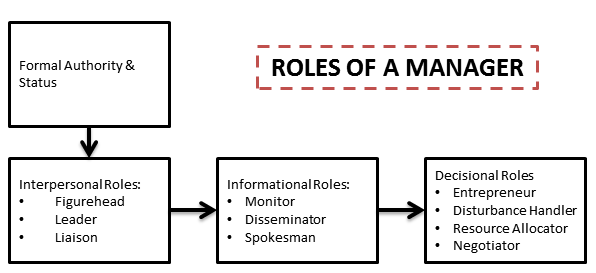Dr. Henry Mintzberg, a prominent management researcher, conducted research to find out what are manager duties or responsibilities.
In 1916 Henri Fayol was the first to define the manager. Dr. Henry Mintzberg wanted to find out if Henri Fayol’s 50-year-old definition of manager and management definition still stood in the 60s and 70s. So he conducted research based on the structured observation method.
For this, Mintzberg observed the daily activities of five executives for one week.
They all were from 5 different types of organizations; a consulting firm, a school, a technology firm, a consumer goods manufacturer, and a hospital. He kept track of all their activities and analyzed it.
His research report titled “MANAGERIAL WORK: ANALYSIS FROM OBSERVATION” was for his doctoral dissertation at the Sloan School of Management, M. I. T.
In January 1971, he submitted the report, and it was accepted and published in October 1971.
In his research, Mintzberg said that what managers do can best be described by looking at their work roles.
The term management role refers to specific categories of managerial behavior.

He identified 10 identified roles a manager plays in an organization which fall into 3 basic categories:
- Interpersonal roles,
- Informational roles.
- Decisional roles.
Interpersonal Roles
These roles relate to the manager’s behavior that focuses on interpersonal contact. Interpersonal roles are roles that involve people (subordinates and persons outside the organization) and other duties that are ceremonial and symbolic.
The three interpersonal roles include being a;
- Figurehead.
- Leader.
- Liaison.
According to Dr. Henry Mintzberg, These three interpersonal roles derive from the authority and status associated with managers’ posts.
1. Figurehead
The figurehead performs symbolic legal or social duties. All social, inspirational, legal, and ceremonial obligations.
In this light, the manager is seen as a symbol of status and authority.
2. Leader
The Leader builds relationships with employees and communicates with, motivates, and coaches them.
Duties are at the heart of the manager-subordinate relationship and include structuring and motivating subordinates, overseeing their progress, promoting and encouraging their development, and balancing effectiveness.
3. Liaison
The liaison maintains a network of contacts outside the work unit to obtain information.
Describes the information and communication obligations of a manager. One must network and engage in information exchange to gain access to knowledge bases.
Informational Roles
Informational roles involve receiving, collecting, and disseminating information.
The 3 informational roles include;
- Monitor,
- Disseminator, and
- Spokesperson.
These informational roles are all about receiving and transmitting information so that managers can serve as the nerve centers of their organization. The informational roles are;
4. Monitor
The monitor seeks internal and external information about issues that can affect the organization.
Duties include assessing internal operations, a department’s success, and the problems and opportunities which may arise.
All the information gained in this capacity must be stored and maintained
5. Disseminator
The disseminator transmits information internally that is obtained from either internal or external sources.
Highlights factual or value-based external views of the organization and subordinates. This requires both filtering and delegation skills.
6. Spokesperson
The spokesperson transmits information about the organization to outsiders. Serves in a PR capacity by informing and lobbying others to keep key stakeholders updated about the operations of the organization.
Decisional Roles
Decisional roles revolved around making choices. Managers’ interpersonal role leads to decisional roles.
Information and resources collected and gathered by the interpersonal enable a manager to play the decisional roles or responsibilities that he is obligated to.
The four decisional roles include being an entrepreneur, disturbance handler, resource allocator, and negotiator.
7. Entrepreneur
The entrepreneur acts as an initiator designer and encourages change and innovation.
Roles encourage managers to create improvement projects and work to delegate, empower and supervise teams in the development process.
8. Disturbance handler
The disturbance handler takes corrective action when the organization faces important, unexpected difficulties.
A generalist role takes charge when an organization is unexpectedly upset or transformed and requires calming and support.
9. Resource allocator
The resource allocator distributes resources of all types, including time, funding, equipment, and human resources.
Describes the responsibility of allocating and overseeing financial, material, and personnel resources.
10. Negotiator
The negotiator represents the organization in major negotiations affecting the manager’s areas of responsibility and is an integral task for the spokesman, figurehead, and resource allocator roles.
If we analyze Mintzberg’s findings, we can say that authority and status derive the interpersonal roles; interpersonal makes it necessary for a manager to play informational roles. And that enables a manager to make a decision.
These ten roles of a manager, stated by Mintzberg, come with many responsibilities. Informing, Connecting, and orders require a manager to be able to adapt to the situation and control it in a balanced way.
Mintzberg’s 10 Schools of Strategy
| 1. The Design School | Strategy formation as a process of conception |
| 2. The Planning School | Strategy formation as a formal process |
| 3. The Positioning School | Strategy formation as an analytical process |
| 4. The Entrepreneurial School | Strategy formation as an analytical process |
| 5. The Cognitive School | Strategy formation as a mental process |
| 6. The Learning School | Strategy formation as an emergent process |
| 7. The Power School | Strategy formation as a process of negotiation |
| 8. The Cultural School | Strategy formation as a collective process |
| 9. The Environmental School | Strategy formation as a reactive process |
| 10. The Configuration School | Strategy formation as a process of transformation. |